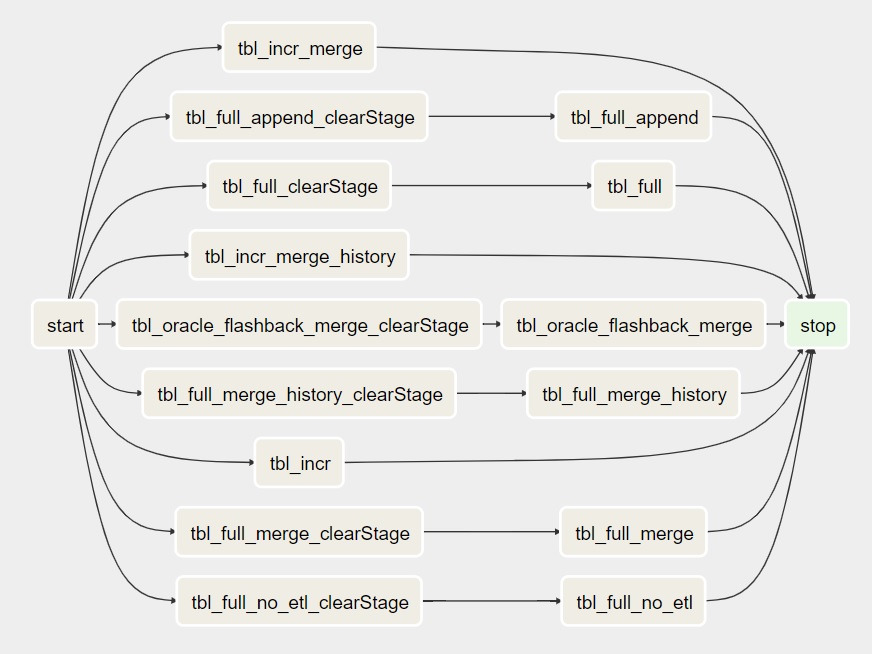

- #Airflow dag dependency how to
- #Airflow dag dependency install
- #Airflow dag dependency full
- #Airflow dag dependency code
#Airflow dag dependency install
If you prefer to keep using network posed container, you can try switch to same use id when login and install you python lib. The docker container may assumpt some environment. In my understanding, you may try to build you airflow image from zero it may work well. Write a simple dags, and use airflow test to see if work work. In order to check you dependecy, you can: Need doubleck you moduel installation via pip.

like : import os if you has get any error message, you in the docker python environment to check if your model properly installed.In order to check if you module properly installed, you may use follow command: check the python path insides the airflow environment, make sure you module can be access.set the dags folder in the airflow.cfg file, put you module file insides the dags folder. develop and test DAGs, custom plugins, and dependencies before deploying to Amazon MWAA.

you can check it by airflow list dags in the docker containers. This page describes the steps to install Apache Airflow Python. Per you question, you should facing issue in environment dependency.
#Airflow dag dependency code
You can do it use following cli commands to check environments and code logic: airflow list dagsĪirflow test Worker exiting (pid: 11446)įor each dags, you need test it before run it. ModuleNotFoundError: No module named 'myLib' When checking container logs, I have the following error: ERROR - Failed to import: /usr/local/airflow/dags/mydag.pyįile "/usr/local/lib/python3.7/site-packages/airflow/models/dagbag.py", line 202, in process_fileįile "/usr/local/lib/python3.7/imp.py", line 171, in load_sourceįile "", line 219, in _call_with_frames_removedįile "/usr/local/airflow/dags/mydag.py", line 7, in The same import does not work in my Airflow DAG. I updated the docker-compose.yml with a volume that maps my host directory with myLib on container airflow home. Once implemented, I want to deploy this latest version of myLib into in the airflow container. In my DAG, I want to use a custom Python library (let's call it myLib feature that is not yet implemented. To clarify what I trying to do, below some details. I failed to understand how I am supposed to deploy my library so that Airflow can pick them up. However when I integrate the same logic in a DAG python file, I got the error "broken dag, no module named inhouse_lib.Īt first I thought that Airflow was picking dependencies in a specific pip directory relative to the Python version and that I installed the library in another pip directory.īut for all by Python binaries, they all use Python 3.7.įor all pip binaries I have (pip, pip3, pip3.7) when doing a pip list, I can find my inhouse library. The not very clean method I use to quickly test is to docker exec into the airflow container and pip install the appropriate library (that are shared through Host machine to container with a Docker volume in read-only mode).Įverything is installed properly with pip and I can use my library when running a dummy Python script. I am trying to test the integration of one of our inhouse library with Airflow. As I wrote in the previous paragraph, we use sensors like regular tasks, so I connect the task with the sensor using the upstream/downstream operator.I am struggling to perform some really simple task with Airflow.įor context, I use docker-compose to run docker containers with Airflow and Postgres. In the default configuration, the sensor checks the dependency status every minute.Īfter I configure the sensor, I should specify the rest of the tasks in the DAG. The sensor is just another type of task, so I create a new DAG which begins with a sensor.
#Airflow dag dependency how to
#Airflow dag dependency full
Have you built a product that does its job, but you feel like it's not reaching its full potential? It's not as automated, intelligent, or user-friendly as you want.


 0 kommentar(er)
0 kommentar(er)
